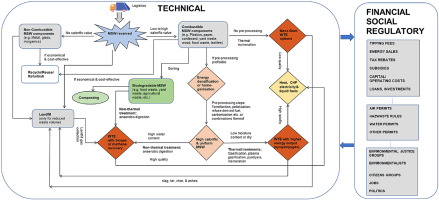Renewable and Sustainable Energy Reviews ( IF 15.9 ) Pub Date : 2019-11-06 , DOI: 10.1016/j.rser.2019.109512 C. Mukherjee , J. Denney , E.G. Mbonimpa , J. Slagley , R. Bhowmik

|
This review on current US municipal solid waste-to-energy trends highlighted regional contrasts on technology adoption, unique challenges of each technology, commonly used decision support tools, and major operators. In US only 13% of MSW is used for energy recovery and 53% is landfilled. There are 86 WTE facilities that mostly use Mass-Burn and Refuse-Derived Fuel technologies and are concentrated in densely populated northeast (predominantly in New York) and the State of Florida. For the rest of the country most of the MSW ends up in landfills equipped with gas recovery, which is supplied to homes or used for electricity generation. However, there are many pilot and experimental systems based on advanced gasification and pyrolysis processes, which are viewed as potential technologies to respond to an issue of landfills nearing full capacity in various US states. These systems are viewed as “cleaner” (65% less toxic residue) than established mass burn technologies but not matured to commercialization due technical and cost hurdles. Operation and maintenance costs between $40-$100 per ton of MSW were reported for gasification systems. The heterogeneous nature of MSW, gas cleaning and air pollution controls are the main disadvantages. Key design and decision support tools used by the scientific community and major operators in US include: Techno-economic analysis, Life cycle sustainability assessment, and Reverse logistics modeling. A conclusion drawn from reviewed studies is that adoption of thermal WTE technologies in US could continue to increase, albeit slowly, in coastal and urban areas lacking suitable lands for new landfills.
中文翻译:

美国城市固体废物转化为能源的趋势回顾
这份对美国当前城市固体废物转化为能源趋势的评论强调了在技术采用,每种技术的独特挑战,常用的决策支持工具以及主要运营商方面的地区差异。在美国,仅13%的城市固体垃圾用于能源回收,而53%的垃圾被填埋。有86个WTE设施主要使用大规模燃烧和垃圾衍生燃料技术,并且集中在人口稠密的东北地区(主要在纽约)和佛罗里达州。在该国其他地区,大部分城市固体废弃物最终都堆放在配备了气体回收装置的垃圾填埋场中,该垃圾填埋场可以供家庭使用或用于发电。但是,有许多基于先进的气化和热解工艺的中试和实验系统,在美国各州,这些技术被认为是解决垃圾填埋场接近满负荷问题的潜在技术。与成熟的大规模燃烧技术相比,这些系统被视为“更清洁”(有毒残留物减少65%),但由于技术和成本方面的限制,尚未成熟到商业化。据报道,气化系统的运营和维护成本为每吨城市固体废弃物40至100美元。城市生活垃圾的异质性,气体清洁和空气污染控制是主要缺点。美国科学界和主要运营商使用的关键设计和决策支持工具包括:技术经济分析,生命周期可持续性评估和逆向物流建模。从经过审查的研究得出的结论是,美国热WTE技术的采用可能会持续增长,尽管速度缓慢,



























 京公网安备 11010802027423号
京公网安备 11010802027423号